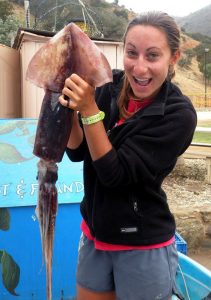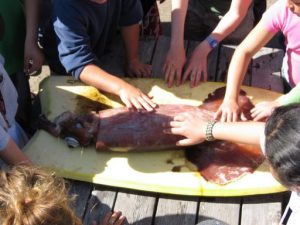A sea of unanswered questions about humboldt squid
by Virginia Ansaldi, RJ Dunlap Marine Conservation Program lab manager

Magen Schifiliti holds up one of the Humboldt squid from Buttonshell beach for a picture. Photo courtesy Magen Schifiliti.
A year ago, I moved out to California to take a job on Catalina Island as an outdoor educator. I worked through the spring and summer, but then my love affair with the island was brought to an end, as I was to attend graduate school back in Miami at the start of fall.
Shortly after leaving the island, my friends there told me that a bizarre amount of Humboldt squid had washed up on the shores of the camp’s cove. Enthralled with pictures of these sci-fi looking creatures, I decided to find out just why so many of them had come to rest on Buttonshell beach.
Dosidicus gigas, also known as the jumbo flying squid or the Humboldt squid (from its prevalence in the Humboldt current), has a historical range from Chile to Baja California. It is occasionally found as north as San Francisco, but never in large numbers or over an extended amount of time, according to a publication titled “Humboldt Squid Migrating to California Waters,”. Video and data collected from 1989 to 2007 by Bruce Robison, and others from the Monterey Bay Aquarium Research Institute were reviewed to study changes in abundance of the Humboldt squid.
PhD Louis Zeidberg of Stanford declared no observation of Humboldt squid in the remote operated vehicle (ROV) cameras from 1989 to 1997. However, in 1997 a number of the squid were counted. The scientists realized that the sighting coincided with an intrusion of warm water into the bay from a strong El Nino event that year.
Other scientists, such as Dr. Nigella Hillgarth, Executive Director of the Birch Aquarium at Scripps Institution of Oceanography in La Jolla, have also come to the conclusion that warmer water coming farther north brings the squid with it.

Students at Guided Discoveries’ Toyon Bay on Catalina Island surround one of the squid from the stranding for a dissection. Photo courtesy Kelly Hatteberg.
However, Humboldt squid only live for a year, two at most, while El Nino events occur every 3-7 years. In an appearance on All Things Considered, NPR radio show, in 2009, Dr. Hillgarth said that it is now generally accepted that there is a permanent year round population of Humboldt squid in the deep waters off of California. Therefore, El Nino-related events alone cannot account for the population of squid in the area. The tendency now seems to be that the squid have colonized the area. Having moved in with the warm water, but now feeding and reproducing locally.
It remains unknown why these animals are coming up so close to the surface. Typically they are found at depths of 1000ft or more. Are they chasing prey? Are they invading waters once populated by their large fish predators now heavily targeted by fishermen? Or are they simply adapting to warmer surface conditions? Answers to these questions are less clear.
Eyewitnesses say they’ve seen the squid venture into the shallows after baitfish where they lose to the waves. Little more than these observations can be found in publications or news releases, a sober reminder of how little we now about the ocean and the animals that inhabit it.
This website does a fantastic job at collecting the research done thus far and alludes to the research discussed in this publication as well. Check it out for more information!



Leave a Reply
Want to join the discussion?Feel free to contribute!